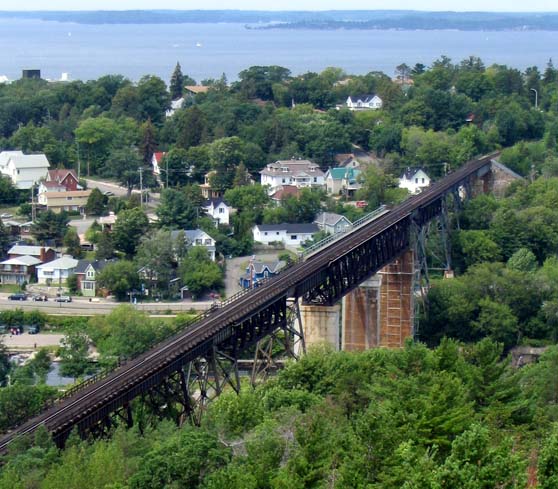
2011
|


The Parry Sound trestle. |
21 September 2011
Correction Measuring Train Sounds
Parry Sound Ontario - Trains are noisy.
Now the question is whether it's something that needs mitigation through the town, or is simply a fact of life.
In a town with two train lines that meander its length, trains' air horns are background noise and the sounds of their wheels on the rails are its pulse.
Another view on train noise though, is it's an unnecessary health risk that needs some mitigation.
"It's interesting, people who aren't close to the train track think it's quite charming and I use the example, "It's something like having a bear in
your back yard," said town resident Josef Bossart. "If you have a bear in your backyard you aren't very happy about it but the neighbour down the
street or on the other side thinks it's pretty cute, you know, we live out in the country we have bears in the country, what do you expect. Get over
yourself."
Bossart measured train noise recently and presented his findings to town council on 6 Sep 2011.
On three occasions he measured the decibels produced by trails rolling along the CN Rail track near his Redwood Drive home.
He then compared the results to the average sound of Bowes Street and downtown Parry Sound.
He also noted the decibels of such things as rock concerts, rustling leaves, and military jets taking off.
He found that the peak levels of train noise measured 15 feet from the track's centre, were 110/120 decibels due to squealing wheels, and the median noise
level was about 85 decibels to 92 decibels.
The average noise level on Bowes Street came in at about 70 decibels and downtown was 59 decibels.
A rock concert is 110 decibels in the front row, rustling leaves are 10 decibels, and a military jet taking off is 140 decibels, he reported.
He told council that between 30 and 40 trains travel each track daily and take up to three minutes from start to finish.
"What you're looking at then, at least on the one rail, you're looking at an hour of this kind of noise every day at intervals nobody knows," said
Bossart.
"Remember, we don't have a schedule here where we have a 6:15 or 8:10 train, you can have it at any time, you can have five at night, one at night, six
during the day, or whatever."
He told council that in speaking with people he found residents are fine with the trains going down the track, but some are upset with the air horn that can
sound as often as 300 times a day at 105 decibels when 100 feet away, while for others, it's the squealing wheels that gets to them.
He refereed to a World Health Organization report on noise pollution, including rail noise in Europe that linked noise to children's cognitive impairment,
cardiovascular disease, sleep disturbances, tinnitus, and annoyance.
He suggested solutions of mitigating the air horn, proper maintenance of trains, sound barriers, and soundproofing homes as possible solutions.
One community in Canada has taken steps to stop noisy nighttime trains.
In 2008 a British Columbia community first filed a complaint with the Canadian Transportation Agency about the nighttime operations of a rail yard and a
mediated solution was reached.
The issue is now going to the Federal Court of Appeal later this month after the agreement wasn't adhered to, according to a local news report and the
railandreason.com website.
CN Rail has changed its policy on air horns, or whistles as they're known in the business, for communities before through municipal bylaws and has an agreement
on guidelines for building homes near railways with the Federation of Canadian Municipalities and Railway Association of Canada, said CN Rail spokesperson
Frank Binder.
The 2007 agreement on issues included expanded rail lines and new developments along railways.
Off branch lines a 15 metre setback and a 2-metre high berm is recommended with those along main lines having a 30 metre set back an d 2.5-metre high berm.
Back in the council chamber on 6 Sep 2011, breaking away from normal procedure, town Mayor Jamie McGarvey invited Kay Wheatley to speak to Bossart's
presentation, with the blessing of council.
Wheatley said she lives near the CP Rail tracks and doesn't mind the train's air horn.
"In this case it's noise for safety," she said. "I just can't see people being overwhelmed with the noise. To me it's being a bit selfish
because that noise could save a life."
Coun. Paul Borneman is a member of the newly established Rail Safety Advisory Committee and a member of a previous committee focusing on the railways.
In an email to the North Star he thanked Bossart for his work and said it quantifies what those living close to the tracks are aware of with the noise,
especially squealing wheels.
"Rail safety is an issue for the entire community as well as those who visit the community," he wrote in an email. " We can never eliminate risk
but we need to determine what can be reasonably done to mitigate those risks. Staff have been working towards this but, perhaps this committee will serve the
community well in designating a vehicle to identify concerns and speak to the railways about potential resolutions and follow up on what has been agreed to.
Noise is an issue where the importance varies more widely".
What is interesting about Mr. Bossart's presentation is that it brings the empirical measurement of noise and potential health risks into the equation,
something that had not been previously considered.
As Joe said, "The railways aren't going away, but hopefully they can be convinced to be good neighbours."
The town is forwarding Bossart's report on to the new Rail Safety Advisory Committee for its consideration.
The town is accepting names of those wishing to sit on the committee until the end of September.
Sarah Bissonette.

|

